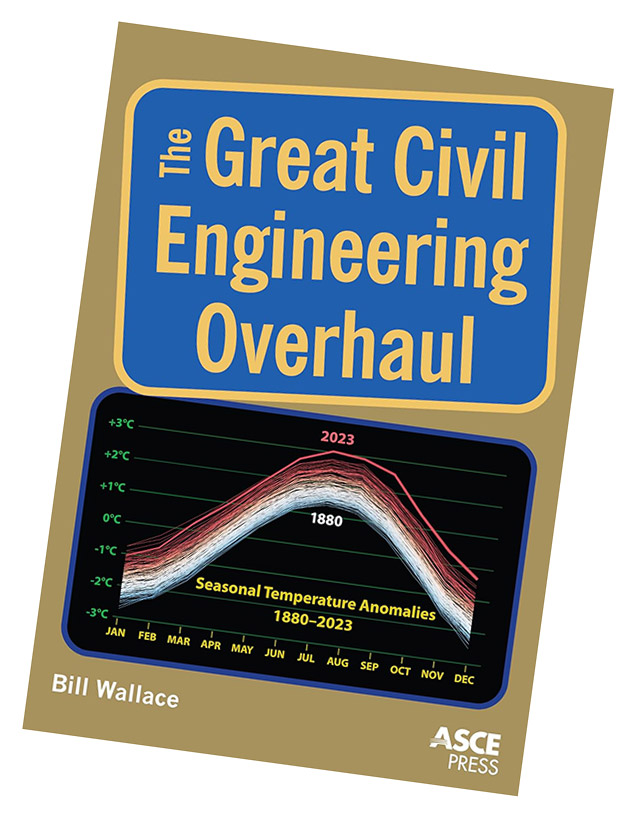
William A. "Bill" Wallace
Long ago, as a teenage science nerd, I read a lot of sci-fi paperbacks and closely followed our nation’s space programs. I remember how one book, Brain Wave by Poul Anderson, described a future in which Earth moves out of a mind-dampening field in space—allowing humans, as well as animals, to become really smart. People’s IQs are off the charts. Tough math problems are solved. These super-intelligent beings invent warp drive, build spaceships and fly around the universe, lots of cool teen science nerd stuff.
Today, I’m thinking maybe this isn’t science fiction. It seems that Earth has moved back into a field of really stupid.
Clear evidence of this can be found in a proposed Republican policy agenda, Project 2025, a publication in which climate change ignorance is a key feature. Never mind that just about every nation on the planet sees it as a threat to civilization as we know it. Drafters of the Project 2025 agenda and Republican presidential candidate Donald Trump call climate change a hoax perpetrated by so-called “climate alarmists.”
But the climate is changing, and we have documented and paid for the disastrous effects: extreme temperatures, rising sea levels, more frequent and intense rainstorms, huge wildfires, record-breaking floods and extended droughts.
Since reporting began in 1980, the National Oceanic and Atmospheric Administration (NOAA) National Centers for Environmental Information has counted 376 climate and weather disasters that have cost U.S. taxpayers more than $2.6 trillion, inflation-adjusted. Not surprisingly, Project 2025 calls for eliminating the agency’s climate research and cost assessment work that it deems "the source of much of NOAA’s climate alarmism."
Climate Action Halt?
According to the Project 2025 policy agenda, any work on the cause of a changing climate (carbon emissions from fossil energy sources) or its impact (rising seas, heat waves, floods, wildfires, storms) would grind to a halt. The energy policy basically becomes “drill, baby, drill!”—obtaining energy from what the authors call reliable and affordable sources: coal, oil and natural gas.
Following this logic, families fleeing from future climate and weather disasters would be somewhat comforted knowing that during their escape, they would have access to cheap gasoline.
Thankfully, Congress was oblivious to the Project 2025 climate nonsense and passed two landmark pieces of legislation in 2021 and 2022: the Infrastructure Investment and Jobs Act and the Inflation Reduction Act. Combined, they represent an investment of $1.25 trillion to both reduce greenhouse gas emissions and create resilient, adaptive infrastructure.
Doing both is essential. The climate has become unstable because of excess greenhouse gases in the atmosphere—more than Earth’s natural systems can process. As a result, the planet continues to warm, now about 1.3℃ above pre-industrial era levels. Above 1.5℃, climate and weather conditions become markedly worse. At 1.5℃, 14% of the global population is exposed to extreme heat; at 2.0℃, the proportion jumps to 37%, 2.6 times worse. Species loss is two to three times greater, and crop and fishery yields drop by a factor of two.
What exists today is something Susan Cutter, director of the Hazards Vulnerability and Resilience Institute at the University of South Carolina, calls a “new normal” of climate and weather disasters. In the past, these were one-off events, leaving communities with sufficient time to recover. Today, these are recurrent acute disasters, called RADs, which happen in rapid sequence to increase the cumulative impact and reduce recovery time interval.
Tough Road
Cutting greenhouse gasses and creating resilient, adaptive infrastructure at the same time won't be easy.
To stay below 1.5℃, climate scientists tell us we must reduce emissions to net zero before 2050. This requires a changeout of our energy systems, replacing fossil energy with renewable energy sources. Any remaining carbon releases must be captured and stored. Infrastructure also must be upgraded or re-engineered to cope with extreme and erratic climate and weather conditions for which it was not designed.

"In the era of climate change, civil infrastructure design problems have been pushed into a domain of deep uncertainty," says the author of this book, just released by the American Society of Civil Engineers Image courtesy of ASCE Press
Doing both requires a revolution, essentially an overhaul of how civil engineering is currently practiced. Arizona State University researchers Mikhail Chester and Braden Allenby say engineers have approached climate impacts in civil infrastructure design as normal—albeit complicated—engineering problems using traditional standards and methods that produce optimization and efficiency.
But in the current era of climate change, civil infrastructure design problems now have been pushed into a domain of deep uncertainty, in which conditions are changing and unpredictable.
Many engineers realize that climate change should be considered in their designs but don't know what to do.
A 2022 survey of architecture and engineering professionals by the University of Minnesota Climate Adaptation Partnership and global design firm HGA found that few use climate projections to make design decisions. The main barriers were that clients were not asking for them, and firms did not have the in-house expertise to apply them.
'Time to Do What's Right'
If you’re an engineer working in the built environment, it’s time to do what’s right.
Take a cue from the UK Institution of Civil Engineers. Its State of the Nation 2021 report told members to refuse business as usual related to climate change ignorance. ('Darn, I don't know much about climate change, but thankfully my client hasn't asked.'). Like safety, the report stated that carbon should be part of every client conversation ('How can we cut the project’s carbon footprint?'). Institution members were told to be responsible for resilience ('We stress-tested the design for a wide range of climate extremes.').
To instigate this transformation, I wrote a book, The Great Civil Engineering Overhaul (American Society of Civil Engineers, 2024), which provides students, engineers, industry practitioners, owners, officials and anyone else with concepts, methods and tools to handle what could be the greatest set of opportunities they will ever have in their careers.
Recognizing the abundance of climate nonsense, the book starts with the basics: the importance of civil infrastructure and the relationship between climate, sustainability and infrastructure resilience. It then addresses the deep uncertainties of future climate conditions and presents methodologies and case examples showing how engineers are handling changing conditions.
The opportunities are right in front of you. Funds now are being invested to reduce carbon emissions and improve infrastructure resilience. Many federal and other credible authorities offer deep detail on how the climate is changing and its effects on the built environment.
Engineers: it is time to lead. You know what works and what doesn’t. Your project delivery experience is all about managing change. If not you, then who?
William A. “Bill” Wallace is a consultant and university lecturer with more than 40 years of professional experience, including 30 years in environmental engineering and project management He is a recognized expert in sustainable development who was cited by ENR as a 2014 Newsmaker for his invention of the Institute for Sustainable Infrastructure’s Envision Rating System. Wallace's 277-page book, The Great Civil Engineering Overhaul, was recently published by the American Society of Civil Engineers as a resource for sustainable infrastructure design. He can be reached at billw5909@gmail.com




